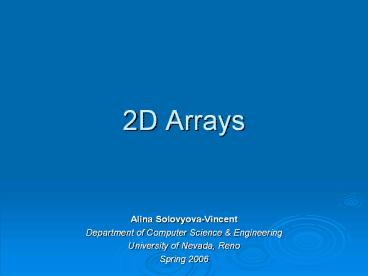2D Arrays - PowerPoint PPT Presentation
Title: 2D Arrays
1
2D Arrays
Alina Solovyova-Vincent Department of Computer
Science Engineering University of Nevada,
Reno Spring 2006
2
Declarations
- datatype array_name num_of_rows num_of_col
- int array_11010 // indexed from (0,0) to
(9,9) - char array_234 //indexed from (0,0) to
(2,3) - float array_3210 //indexed from (0,0) to
(1,9)
The first index always indicates the row, the
second the column.
3
Declarations
- char letters34
- or
- const int row 3const int col 4char
lettersrowcol //preferred way
4
1-D vs. 2-D Arrays
0,0 0,1 0,2 0,3 0,4
1,0 1,1 1,2 1,3 1,4
2,0 2,1 2,2 2,3 2,4
3,0 3,1 3,2 3,3 3,4
4,0 4,1 4,2 4,3 4,4
0
1
2
3
4
5
int table43
- 72 45 1562 10 019 99 2738 24 89
table22
6
Examples
- float array_A122
- char array_B73
- int array_C410
7
Row-Major Order
- 72 45 1562 10 019 99 2738 24 89
- 72451562100199927382489 ? ?
8
Initialization
- int nums34 2,4,6,8,1,3,5,7,5,2,7,10
- int nums34 2,4,6,8,
- 1,3,5,7,
- 5,2,7,10
- int nums34 2,4,6,8,
- 1,3,5,7,
- 5,2,7,10
9
Accessing All Elements of an Array
- for ( i 0 i lt row i )
- for( j0 jltcolumn j ) cout ltlt
bunch_of_numsij ltlt \t - cout ltlt endl
10
Accessing Individual Elements
- int numint bunch_of_nums1010bunch_of_n
ums00 25num bunch_of_nums35
11
Using Subscript Expressions
- result result value i 2 i num
- cout ltlt num i row col-6
12
Worksheet
- Declare an array to store 5x5 matrix of integers.
- List all of the elements on the major diagonal.
- List all of the elements on the minor diagonal.
- Write a code segment that would display all of
the elements on the major diagonal. - Write a code segment that would display all of
the elements on the minor diagonal.
13
- const int size 5
- int squaresizesize
- // display major diagonal in one loop
- for (int i 0 i lt size i)
- cout ltlt squareii ltlt endl
- // display minor diagonal in one loop
- for (int i 0 i lt size i)
- cout ltlt squareisize-1-i ltlt endl
14
- const int size 5
- int squaresizesize
- // display major diagonal in two loops
- for (int i 0 i lt size i)
- for (int j 0 j lt size j)
- if (i j)
- cout ltlt squareij ltlt endl
- // display minor diagonal in two loops
- for (int i 0 i lt size i)
- for (int j 0 j lt size j)
- if (i j size-1)
- cout ltlt squareij ltlt endl
15
Worksheet
- Write a code segment that declares
- 45 x 33 array of integers and initializes
all elements to 0. The program should then prompt
the user for a location in that array ( row
number, column number) and tell the user whether
its a valid location ( i.e. within bounds). For
example (4, 16) is a valid, (-3, 5) is invalid,
(13, 56) is invalid. If location is valid,
display the contents of that location.
16
- const int nrow 45
- const int ncol 33
- int arrnrowncol 0
- do
- cout ltlt "Enter row and column "
- cout ltlt r ltlt c
- while (r lt 0 r gt nrow
- c lt 0 c gt ncol)
- cout ltlt "The element in ("
- ltlt r ltlt ", " ltlt c ltlt ") is "
- ltlt arrrc
17
2-D Arrays in Functions
- void ProcessValues (int 5, int, int)
- //works with ALL 2-d arrays that have
- // exactly 5 columns i.e. 10x5, 2x5 .
18
- int max(int 2, int, int)
- void main()
- const int nrow 4, ncol 2 int
numsnrowncol 3,2,5,13,1,7,9,4 - cout ltlt "The max value of the array is "
- ltlt max(nums, nrow , ncol)
- int max(int vals 2, int nr, int nc)
- int i, j, max vals00
- for (i 0 i lt nr i) for (j 0
j lt nc j) if (max lt valsij)
max valsij - return max
19
Worksheet
- Write a function that receives an array of
floating point values, number of rows and number
of columns (known to be 7) in that array, and a
special number between 0 and 6. The function
should return the sum of all elements in the
column that corresponds to the special number.































